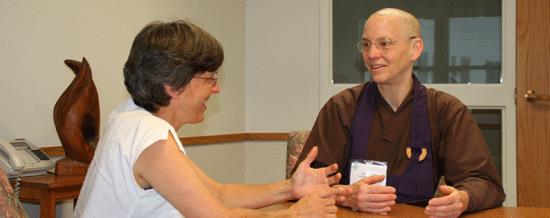May Christ bring us all together to everlasting life. Rule of Benedict
When we speak about the path, we should keep in mind that there is only one path, and everyone who is going is on that one path. It may look as if people were going in different directions; but as long as they are going, they are just on the path. David Standl-Rast, OSB
St. Mary Monastery was a sight for curious onlookers over Labor Day weekend, when the grounds filled with smooth-headed Buddhist nuns wearing flowing robes, broad smiles and simple sandals. Responding to the call for deeper religious understanding across cultures, they had come to participate in "Nuns in the West," a project sponsored by the Monastic Interreligious Dialogue.* They had come to share their practices, and to learn more about those of the Benedictines, who also had come from all around the country.
What they discovered - the Benedictines and the Buddhists - was that their practices, while arising from profoundly different origins, are surprisingly similar. Sr. Anne McCarthy, OSB (Benedictine Sisters of Erie, Penn., pictured at left above) and Rev. Vivian Gruenenfelder (Soto Zen Buddhist of Shasta Abbey, Mount Shasta, Calif., pictured at right) agreed to answer some questions about their beliefs and practices for Connecting Point.
CP: Can you describe your prayer practices?
Rev. Vivian: Actually, Buddhists don't pray. Prayer implies a duality where there's a self and an other. We don't think in terms of an 'other.' Buddhism begins with unity and oneness with Buddhist Nature. There's no one to pray to or supplicate or express gratitude or contrition to.
We see everything as sacred, and experience that truth in meditation. We understand we are completely united with all things.
Sr. Anne: That reminds me of Benedict's 12th Step of Humility, bowing in reverence not just in the chapel but in the field or wherever you are.
Rev. Vivian: Yes! And how about his instruction to care for all tools as if they were vessels of the altar?
Sr. Anne: Mindfulness is very important in monasticism, and monasticism is important to opening us to wisdom. Is the world different because monasticism exists? My great hope is yes; that our emphasis on love and healing helps reduce suffering. Are we, as monastics, bringing more healing and love into the world?
Rev. Vivian: Someone has to hold everything in the world sacred, and that depends more on practice than on doctrine.
CP: What is your daily life like?
Rev. Vivian: It can vary a lot, but it goes something like this:
5:30-6:30 a.m. meditation, 6:30-7:30 chant, 7:30-8:15 a short work period, and 8:15 breakfast. We work until our midday meal, followed by an hour of rest, and work until 4 p.m. We have a short meditation and chant then, followed by a light supper, rest and spiritual reading. We meditate and chant before bed, which is at 9 p.m. We recite the core Sutras - Buddha's teachings - together every day.
Sr. Anne: That reminds me of the Benedictine recitation of the Psalms during our Liturgy of the Hours. (Although all Benedictine monasteries adopt their own schedules, most pray Lauds in the morning, Noon Day before lunch, and Vespers in the evening, along with Eucharist.) We follow Jesus' instruction to "pray always" by chanting the Psalms and by doing Lectio Divina, or spiritual reading. It's not just intellectual reading, but a deeper way of reading that allows us to become the Scriptures.
Rev. Vivian: We seek to be "mindful always" with our meditation and readings. Also, work is integral to our meditation process. We consider ourselves a contemplative order, but spend a lot of time working.
CP: In what ways do you believe your orders to be profoundly different?
Rev. Vivian: One visible difference is that, since Vatican II, the Benedictines no longer wear robes, while we have gone back to our roots and now wear robes. The Buddha instructed us to dress differently from the laity, to make us visible in the world as monks.
Sr. Anne: (laughing) Even there we are alike, it seems to me. Catholic monastics were urged to return to their roots after Vatican II. We stopped wearing habits because we were to dress like the simple people of our day, as Benedict urged in his time. The habit came from medieval times.
Rev. Vivian: As monastics, we are profoundly similar. Our doctrine is profoundly different, however. We don't pray to the Buddha. He's a teacher and we follow his teachings - although Jesus was, too.
Sr. Anne: Our individual relationships with Jesus certainly are different. We pray to him, pray to God.
CP (to Rev. Vivian): If you don't believe in God, how do you explain creation?
Rev. Vivian: It's a good question, but we don't try to answer it. We're here, so we want to make the best of it. We have no creation story, no end story. We work to bring an end to suffering and to experience our union with all that is, and we hold that sacred.
* Monastic Interreligious Dialogue (MID) is an organization of Benedictine and Trappist monks and nuns committed to fostering interreligious and intermonastic dialogue at the level of spiritual practice and experience between North American Catholic monastic women and men and contemplative practitioners of diverse religious traditions
